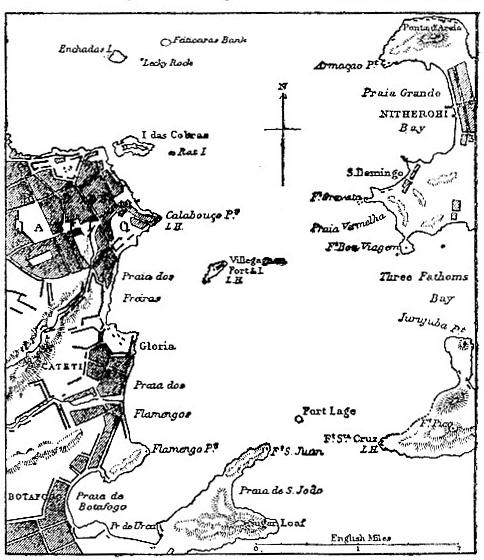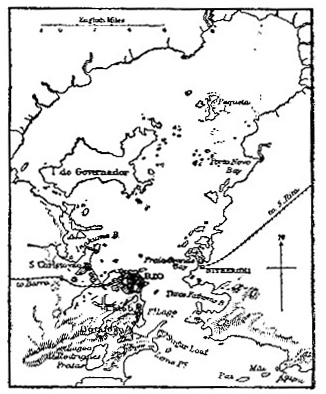1902 Encyclopedia > Rio de Janeiro
Rio de Janeiro
RIO DE JANEIRO (in full form SAO SEBASTIAO DO RIO DE JANEIRO, and colloquially shortened to RIO), the capital of Brazil, and one of the principal seaports of South America, is situated on the western side of one of the finest natural harbors in the world in 25° 54’ 23" S. lat. and 43° 8’ 34" W. long. (the position of the observatory). Along with its environs it is separated from the province of Rio de Janeiro (whose chief town is Nitherohi) and constitutes an independent municipality (municipio neutro), with an area of about 540 square miles, divided into nineteen (formerly sixteen) parishes or frequezias.
Most of the streets are narrow and meanlooking; even the fashionable Rua do Ouvidor which is lined on both sides with handsome shops, is a mere alley. The Rua Direita, or, as it is now called officially, Rua Primeiro de Marco, is the principal business street, and is wide and pleasant. It runs from the gate of the royal palace (a building of small pretensions) to the convent of Sao Bento, and contains the exchange, the post office, and the custom-house, as well as the imperial chapel (1761) and several other churches.

Rio de Janeiro and its Environs
The churches and monastic buildings of Rio de Janeiro number upwards of fifty, mostly built in the "Jesuit" style, but striking from their size and the barbaric magnificence of their decorations, as well as on account of their well-chosen sites. La Candellaria (17th century) is conspicuous from the height of its towers, and La Gloria crowns a beautiful eminence on the bay. The monastery of Sao Bento is reputed to be the wealthiest in the empire, with large possessions in land and mines; and its chapel is not unworthy of that reputation.
Besides the famous hospital of Don Pedro II., better known as La Misericordia, because built (1841) on ground belonging to the fraternity of that name, there are several smaller institutions of the same class in the city; and a large and handsome lunatic asylum, founded in 1841 with funds obtained by selling titles of nobility at a fixed tariff, occupies a good position in the Botafogo suburb. The military hospital is also an extensive establishment.
Among the literary and scientific institutions of the city, the College Dom Pedro II. (which is well organized), national museum, institute of history, geography, and ethnology (1838), polytechnic institute, national educational museum, polytechnic school, military, naval, and normal schools, lyceum of arts, musical conservatory, geographical society, and astronomical and meteorological observatory deserve special mention. The great national library owes its foundation to the bequest of Joao VI., and now numbers upwards of 120,000 volumes open to the public daily (see LIBRARIES, vol. xiv. p. 530, where the lesser libraries are also mentioned).
One of the pleasant features of the city is the abundant supply of excellent water distributed to numerous stately fountains in the streets and public squares. The chief aqueduct, begun in the middle of the 17th century, starts at Tijuca, about 12 miles distant, and crosses the valley (740 feet wide and 90 feet deep) between Monte de Santa Theresa and Monte de Santo Antonio by a beautiful double tier of arches (erected in 1750), which form a striking feature in some of the finest views of the city. Its entire length being covered in with stone work, the water is kept remarkably cool. As the city has extended, other aqueducts of less architectural pretensions have had to be constructed; and a good deal has been done by an English company in recent years to provide a proper system of sewers.
The bay of Rio de Janiero has been the subject of poetic panegyric ever since it was discovered; and the traveler who comes to it after a voyage round the world seems as susceptible to its charms as if it were his first tropical experience. The actual entrance, between Fort St Juan and Fort Santa Cruz, is 1700 yards wide. Within there are fifty square miles of anchorage, or even more for vessels of light draught, the bay having a width varying from 2 to 7 miles and stretching inland from the sea for 16 miles. Its coast-line, neglecting minor indentations, measures 60 miles. Such a sheet of water would be beautiful anywhere; but when on all sides it is surrounded by hills of the most varied contour, the beauty is enhanced a thousandfolds. Its surface is broken by a large number of islands -- from the Ilha do Governador (6 miles long and 2 broad; population 2500) down to the little cluster of the Jerubahibas.
Rio is the seat of the principal arsenal in the empire, and most of the Brazilian cruisers have been built in its dockyards. The roadstead for vessels of war is between Villeganon Island, with its fort, and the islands at the north-east angle of the town called respectively Ilha das Cobras (Snake Island) and Ilha dos Ratos (Rat Island). On the north side of Ilha das Cobras is he naval arsenal with two large docks. On Ilha das Enchadas (Coating Island) there is a fine commercial dock 385 feet long, on keel blocks, 45 feet wide at the entrance and 23 feet deep. Between 1846 and 1855 the average number of vessels that cleared from the port of Rio was over 680 with an average total burden of 221,280 tons. In 1867 1311 vessels (522,407 tons) entered and 1032 (696,663 tons) cleared; in 1883 1218 (1,220,330 tons) entered and 1067 cleared, while, besides, the coasting trade was represented by 1414 vessels (454,739) entering England has the greatest share of the foreign shipping trade, Germany ranking next, and France third. How completely (in spite of the fact that Santos and Rio Grande have become more independent) Rio de Janiero is the commercial as well as the political capital of Brazil is evident from the fact that the exports from Rio are on the average fully equal in value to those from the rest of Brazil; for instance, the value of the exports from the capital in 1859-60 was £5,933,850 out of £11,826,121 from the empire, in 1879-80 £10,566,800 out of £18,928,635, and in 1881-82 £7,550,966 out of £18,522,050. to this large total coffee has long contributed 40-50 per cent, and in 1880-81 (an exceptional year) the ratio rose to 86 per cent. Though the coffee plant was not introduced till 1770, Brazil is the greatest producing country in the world, and Rio de Janeiro is consequently the largest coffee-exporting city. The other exports of moment are brandy (in decreasing quantities), sugar, hides, diamonds, tapioca, (mainly to France) tobacco, and cigars, medicinal herbs, gold dust, and jacaranda, rosewood, and other timbers. The imports comprise cotton goods, machinery, pitch pine, and petroleum. Among the comparatively few local industries are he weaving of colored buckskins (by a German firm) and other woolen and half woolen stuffs, the extensive manufacture of artificial mineral waters and liquors, brewing, carriage building, and hat-making. Rio de Janeiro is the terminus of the Dom Pedro II. Railway, and thus of nearly the whole railway system of the country; and it communicates regularly by steamer with Nitherohi on the other side of the bay, which is the terminus of another line. The population of the municipality of Rio de Janeiro was in 1850 stated at 266,466, of which 205,906 were in the town proper; but this, like most of the earlier figures appears to be an exaggeration, as the census in 1872 gave only 274,972 of which about 190,000 were in the town and suburbs, the slaves numbering 48,939 and the foreigners (mainly Germans, French, and Italians) 84,279. The Italian element has been rapidly increasing. The bulk of the population is Portuguese with a mixture of Negro blood. The native Indian races are scarcely represented.
The annual rainfall at Rio de Janeiro is about 60 inches, the greatest precipitation taking place in February (12 inches), and the least in August (under 1 inch). The monthly ranges of temperature for 1882 were – January 97° - 68°, February 95° - 68°; March 95° - 69°; April 87° - 64°; May 84° - 60°; June 82° - 59°; July 85° - 59°; August 98° - 54°; September 80° - 50°; October 92° - 59°; November 97° - 59°; December 96° - 62°.

Harbour of Rio de Janeiro
The bay of Rio de Janiero, the Nitherrohi or "Hidden Water" of the natives, was first observed on 1st January (hence the name) by Alphonso de Souza, who supposed, as the Rio indicates, that he had discovered the mouth of a large river. How Villegagnon in 1558 took possession of the island which now bears his name but was then called afte4r his patron Coligny, and how his colony was destroyed by the Portuguese, has been told in the article BRAZIL, 9vol. iv. p. 229). The city of Rio de Janeiro did not become the capital of the viceroyalty till 1763, when Jose I. chose it in preference to Bahia because it was a better center for defensive operations against the Spaniards. In 1711 it had been captured by Duguay-Trouin, who exacted 70,000 cruzados as ransom. It became the residence of the Portuguese royal family in 1808; in the same year its port was declared free to foreign; and in the course of a short time it was made by Dom Joao VI. The seat of so many important institutions that Portugal became jealous at finding the relation between mother country and colony practically reversed. When Jaoao VI. returned to Portugal and Pedro was declared emperor of Brazil in 1822, Rio de Janiero naturally remained the capital of the new state. Ecclesiastically the city was at first (from the foundation of the church of Sao Sebastiao by Mendo de Sa in 1567) subject to the diocese of Bahia (San Salvador). It was made a suffrages bishopric of Bahia by papal bull of 19th July 1576; and when Bahia was by the bull of 16th November 1676 created the metropolitan archbishopric of Brazil, Rio de Janeiro (along the Pernambuco) declared a bishopric, the bishop’s authority extending over the province of Espirito Santo northwards and southwards to the Rio de la Plata (Rio da Prata). The first bishop relinquished his dignity without taking possession; and the second did not reach his diocese till 1682, when he made the church of St Sebastian on the Castle Hill his cathedral. This distinction was in 1734 transferred to the Church of the Cross and in 1738 to that of the Rosary. A new cathedral was begun in 1749 by D. Frei Antonio do Desterro, but the works were discontinued on his death, and in 1840 the materials served for the military academy.
See Milliet de Saint-Adolphe, Diccionario do Imp. do Brazil, Paris, 1845; G. Gardiner, Travels in the Interior of Brazil, 1846; Burmester, Reise nach Brasilien, Berlin, 1853; Herbert H. Smith, Brazil, 1880; C.F. van Deiden Laerne, Brazil and Java, 1885. (H.A.W.)
The article above was written by Hugh A. Webster, formerly Librarian, Edinburgh University; editor of the Scottish Geographical Magazine; sub-editor of the Encyclopaedia Britannica.
|

